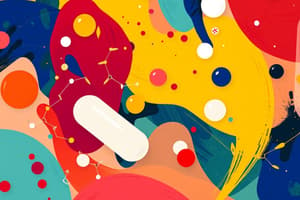Podcast
Questions and Answers
What is the primary function of disintegrants in solid dosage forms?
What is the primary function of disintegrants in solid dosage forms?
- Improve the aesthetic appearance of the product
- Mask unpleasant flavors in syrups
- Facilitate the breakup and disintegration of tablets (correct)
- Protect tablet ingredients from moisture
Which of the following is an example of a coloring agent excipient?
Which of the following is an example of a coloring agent excipient?
- Water
- Specific dyes certified by the FDA (correct)
- Hydroxy propylmethyl cellulose
- Mannitol
What is the purpose of sweeteners in solid dosage forms?
What is the purpose of sweeteners in solid dosage forms?
- Provide stability to the formulation
- Facilitate disintegration of the tablets
- Impart a sweet taste to the formulation (correct)
- Act as a dissolving agent for active ingredients
Which excipient is primarily used for coating solid dosage forms?
Which excipient is primarily used for coating solid dosage forms?
What is one of the functions of solvents in pharmaceutical formulations?
What is one of the functions of solvents in pharmaceutical formulations?
Which function do flavors serve in solid dosage forms?
Which function do flavors serve in solid dosage forms?
What role do disintegrants play in the manufacturing of solid dosage forms?
What role do disintegrants play in the manufacturing of solid dosage forms?
Which of the following excipients is NOT typically used for disintegration in solid dosage forms?
Which of the following excipients is NOT typically used for disintegration in solid dosage forms?
Which of the following excipients are classified as sweetening agents?
Which of the following excipients are classified as sweetening agents?
What is the main function of gelling agents in liquid dosage forms?
What is the main function of gelling agents in liquid dosage forms?
What is the primary function of co-solvents in liquid dosage forms?
What is the primary function of co-solvents in liquid dosage forms?
Which excipient is used primarily to form a base for dissolving active ingredients in suppositories?
Which excipient is used primarily to form a base for dissolving active ingredients in suppositories?
Which excipient category is primarily used to prevent microbial growth in formulations?
Which excipient category is primarily used to prevent microbial growth in formulations?
Which of the following correctly describes the function of stiffening agents?
Which of the following correctly describes the function of stiffening agents?
What is the role of buffers in liquid dosage forms?
What is the role of buffers in liquid dosage forms?
Which of the following options is an example of a flavor imparting agent?
Which of the following options is an example of a flavor imparting agent?
Which of the following is an example of a thickening agent used in liquid formulations?
Which of the following is an example of a thickening agent used in liquid formulations?
Emulsifying agents are primarily used for what purpose in liquid dosage forms?
Emulsifying agents are primarily used for what purpose in liquid dosage forms?
What is the primary purpose of excipients in drug formulations?
What is the primary purpose of excipients in drug formulations?
Which of the following is NOT considered an ideal property of excipients?
Which of the following is NOT considered an ideal property of excipients?
Which of the following is NOT a source of natural products for drugs?
Which of the following is NOT a source of natural products for drugs?
What type of interaction involves both the drug and the excipient?
What type of interaction involves both the drug and the excipient?
Which excipient category is primarily responsible for providing cohesive qualities in a formulation?
Which excipient category is primarily responsible for providing cohesive qualities in a formulation?
Which of the following is an example of a semi-synthetic drug?
Which of the following is an example of a semi-synthetic drug?
What aspect of drug administration can cause issues with active pharmaceutical ingredients (APIs)?
What aspect of drug administration can cause issues with active pharmaceutical ingredients (APIs)?
What is the primary function of lubricants in solid dosage forms?
What is the primary function of lubricants in solid dosage forms?
Which of the following examples is categorized as a filler excipient?
Which of the following examples is categorized as a filler excipient?
What undesirable qualities can APIs have at the site of administration?
What undesirable qualities can APIs have at the site of administration?
Which of the following statements about APIs is correct?
Which of the following statements about APIs is correct?
Which property of excipients is important for their long-term stability in formulations?
Which property of excipients is important for their long-term stability in formulations?
What is a key benefit of chemically modifying natural products to create semi-synthetic drugs?
What is a key benefit of chemically modifying natural products to create semi-synthetic drugs?
What role do glidants serve in solid dosage forms?
What role do glidants serve in solid dosage forms?
Which of the following is NOT a function of excipients used in solid dosage forms?
Which of the following is NOT a function of excipients used in solid dosage forms?
Which of the following best describes excipients in pharmaceutical formulations?
Which of the following best describes excipients in pharmaceutical formulations?
Flashcards are hidden until you start studying
Study Notes
Excipients
- Excipients are pharmacologically inactive substances that are formulated alongside the active pharmaceutical ingredient (API).
- They function to provide bulk, facilitate drug absorption or solubility, aid in manufacturing, provide stability, and prevent denaturation.
- Ideal properties of excipients include:
- Chemical stability
- Pharmacological inertness
- Ease of handling
- Acceptable organoleptic characteristics (taste, smell, appearance)
- Cost-effectiveness
- Non-toxicity
- Non-reactivity
Drug (API) Handling
- Direct clinical use of the active drug substance is rare.
- Some APIs are difficult to handle due to low doses (e.g., mg and µg).
- APIs can benefit from reducing exposure to environmental factors such as light and moisture.
- Degradation of APIs can occur at the site of administration (e.g., low pH in the stomach).
- High concentrations of APIs at the site of administration may cause local irritations or injuries.
- APIs can have unpleasant organoleptic qualities (taste, smell, etc.).
Sources of Drugs
- Natural Products:
- Plants: Drugs found in plant parts like roots, leaves, and stems. Examples: caffeine, morphine.
- Animals: Examples include beef/pork insulin for diabetes mellitus.
- Mineral sources: Found in natural resources such as petroleum. Example: mineral oil (oral laxative).
- Molds and yeast: Drugs are isolated and purified from molds like Penicillin-G from green Penicillium notatum molds.
- Synthetic drugs: Chemically synthesized moieties. Example: acetaminophen (paracetamol).
- Semi-synthetic drugs: Chemically modified natural products. Example: Ampicillin (semisynthetic penicillins).
Solid Dosage Forms
- Disintegrants:
- Facilitate disintegration/breakup of the dosage form after administration.
- Examples: Starches
- Coloring Agents:
- Impart aesthetic appearance and are used for identification.
- Examples: Dyes (must be approved and certified by the FDA).
- Flavors:
- Mask unpleasant flavors.
- Example: Syrups
- Sweeteners:
- Impart sweet taste to the formulation.
- Example: Mannitol
- Coating Materials:
- Protect tablet ingredients from deterioration by moisture.
- Help swallowing unpleasant tasting tablets.
- Example: Hydroxypropylmethylcellulose (HPMC)
- Diluents (Fillers):
- Make up the bulk of solid dosage forms when the drug itself is insufficient.
- Examples: Lactose, dextrose
- Binders and Adhesives:
- Impart cohesive qualities to powdered material.
- Improve free flow by forming granules.
- Examples: Acacia, Gelatin
- Lubricants:
- Reduce inter-particle friction and prevent adhesion of the tablet material to surfaces.
- Facilitate tablet ejection from the die cavity.
- Example: Magnesium Stearate
- Glidants:
- Added in a dry state prior to compression.
- Reduce friction between particles.
- Improve flow characteristics of the powder mixture.
- Example: Corn Starch
Liquid Dosage Forms
- Solvents:
- Dissolve the solute/active pharmaceutical ingredient (API).
- Examples: Water, alcohol
- Co-solvents:
- Increase the solubility of a solute in water.
- Examples: Ethanol, Glycerin
- Buffers:
- Maintain the pH of the formulation.
- Example: Phosphate buffers
- Antimicrobial Preservatives:
- Prevent microbial growth in formulations.
- Example: Benzyl alcohol
- Antioxidants:
- Control oxidation.
- Example: Ascorbic acid
- Thickening Agents:
- Prevent sedimentation and modify viscosity.
- Example: Hydroxyethylcellulose
- Humectants:
- Retard evaporation of aqueous vehicles from dosage forms.
- Example: Glycerol
- Emulsifying Agents:
- Promote and maintain the dispersion of finely subdivided particles of liquid in vehicles where it is immiscible.
- Example: Tween
- Sweetening Agents:
- Impart sweetness to the formulation.
- Examples: Sucrose, Saccharin, Aspartame
- Colors:
- Impart color to the formulation.
- Example: Amaranth
- Flavors:
- Impart flavor to preparations.
- Examples: Aromatic waters, syrup
Semisolid Dosage Forms
- Gelling Agents:
- Increase the viscosity of a substance and form gels.
- Example: Carboxymethylcellulose (CMC)
- Emollients:
- Soften the skin or soothe irritated skin or mucous membranes.
- Example: Glycerin
- Suppository Bases:
- Used to form a base for dissolving the active ingredient.
- Example: Cocoa butter
- Stiffening Agent:
- Increases thickness or hardness of preparations, usually an ointment.
- Example: White soft paraffin
- Levigating Agent:
- An intervening agent used to reduce the particle size of a powder by grinding, often in a mortar.
- Example: Mineral oil
Studying That Suits You
Use AI to generate personalized quizzes and flashcards to suit your learning preferences.




